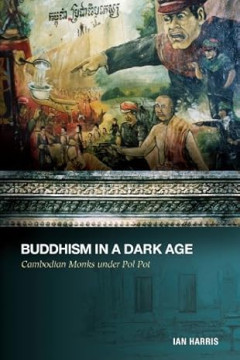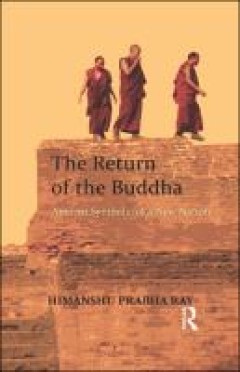Ditapis dengan
E-book Unsettling Translation : Studies in Honour of Theo Hermans
Like most people of my generation, I first came across Theo Hermans’s work when I read The Manipulation of Literature: Studies in Literary Translation, the widely celebrated and agenda-setting volume he edited in 1985. Routledge’s reprint of the volume in 2014 seems to be based on a scan of the original, which was typed by his late wife Marion, probably on an electric typewr…
- Edisi
- -
- ISBN/ISSN
- 9781003134633
- Deskripsi Fisik
- 281 hlm
- Judul Seri
- -
- No. Panggil
- 294.3 AHL u
E-book Buddhism and International Humanitarian Law
International humanitarian law (IHL), now synonymous for many withjus inbello, is the branch of international law that governs the conduct of war. Eventhough the main instruments of IHL have been universally ratified, however,and IHL is perhaps the most effective means so far developed to limit theeffects of war, it is notoriously difficult to implement and enforce (Sassòli2007, 46–47; Bartl…
- Edisi
- -
- ISBN/ISSN
- 9781003439820
- Deskripsi Fisik
- 471 hlm
- Judul Seri
- -
- No. Panggil
- 294.3 BAR b
E-book Songs on the Road : Wandering Religious Poets in India, Tibet, and Japan
Wandering religious poets – that is to say, poets for whom wande-ring is a way of life and whose poetry deals with religious themes – can be found in a variety of ancient and modern cultures. In India, Tibet, and Japan the ascetic or saint who travels from place to place has been the subject of both veneration and fear for hund-reds, or even thousands, of years, as is evident i…
- Edisi
- -
- ISBN/ISSN
- 9789176351369
- Deskripsi Fisik
- 154 hlm
- Judul Seri
- -
- No. Panggil
- 294.3 EDH s
E-book Manual of Zen Buddhism
In my Introduction to Zen Buddism, an outline of Zen teaching is sketched, and in The Training of the Zen Monk a description of the Meditation Hall and its life is given. To complete a triptych the present Manual has been compiled. The object is to inform the reader of the various literary materials relating to the monastery life. Foreign students often express their desire to know about what t…
- Edisi
- -
- ISBN/ISSN
- -
- Deskripsi Fisik
- 122 hlm
- Judul Seri
- -
- No. Panggil
- 294.3 SUZ m

E-book Buddhism in a Dark Age: Cambodian Monks under Pol Pot
This pioneering study of the fate of Buddhism during the communist period in Cambodia puts a human face on a dark period in Cambodia’s history. It is the first sustained analysis of the widely held assumption that the Khmer Rouge under Pol Pot had a centralized plan to liquidate the entire monastic order. Based on a thorough analysis of interview transcripts and a large body of contemporary m…
- Edisi
- -
- ISBN/ISSN
- 9780824835613
- Deskripsi Fisik
- 258 halaman
- Judul Seri
- -
- No. Panggil
- 294.309 HAR b
Ebook Gandharan Art and the Classical World: A Short Introduction
This book offers an introduction to Gandharan art and the mystery of its relationship with the Graeco-Roman world of the Mediterranean. It presents an accessible explanation of the ancient and modern contexts of Gandharan art, the state of scholarship on the subject, and guidance for further, in-depth study.
- Edisi
- -
- ISBN/ISSN
- 9781803276953
- Deskripsi Fisik
- 94 halaman, ilus.
- Judul Seri
- -
- No. Panggil
- 930.1

E-book The Ocean of Heroes : A Critical Edition, Translation, and Analysis of…
TheD. ?ak ?arn.ava(“Ocean ofD. ?akas”) is one of the last Tantric scriptures amongthose belonging to the Buddhist Sam.vara tradition. It consists of 51 chapters. Asdiscussed in Section 2 in this monograph, it was developed sometime between thelate-10th and mid-12th centuries, and the basic text of its extant version was mostlikely completed around the early 12th century in the eastern par…
- Edisi
- -
- ISBN/ISSN
- 9783036520315
- Deskripsi Fisik
- 420 hlm
- Judul Seri
- -
- No. Panggil
- 294.3 SUG t
E-book Buddhism in Central Asia I : Patronage, Legitimation, Sacred Space, an…
The present volume is the proceedings of the start-up conference “Establishing of Buddhist Nodes in Eastern Central Asia 6th to 14th C. Part I: Sacred Space, Pilgrimage, Patronage, Legitimation Strategies” of the BuddhistRoad project, which was held at Ruhr-Universität Bochum on 23–25 May, 2018.1 The themes chosen for this volume are similar to those that constitute the research …
- Edisi
- -
- ISBN/ISSN
- 9789004417731
- Deskripsi Fisik
- 342 hlm
- Judul Seri
- -
- No. Panggil
- 294.3 DEE b
E-book E-book The Monastery Rules : Buddhist Monastic Organization in Pre-Mod…
Monasteries traditionally played a large role in the lives of ordinary people in Tibet. To date, however, relatively little is known about the role of these monasteries and their inhabitants in Tibetan society. Still, the impact of monastic Buddhism on other expressions of Buddhism as well as on a wide range of aspects of Tibetan culture has been tremendous. By contrast, whereas Christian monas…
- Edisi
- -
- ISBN/ISSN
- 9780520297005
- Deskripsi Fisik
- 300 hlm
- Judul Seri
- -
- No. Panggil
- 294.3 JAN t
E-book The Roots of Good and Evil
The Buddha has taught that there are three roots of evil: greed, hatred and delusion. These three states comprise the entire range of evil, whether of lesser or greater intensity, from a faint mental tendency to the coarsest manifestations in action and speech. In whatever way they appear, these are the basic causes of suffering. These roots have their opposites: non-greed, non-hatred and non-d…
- Edisi
- -
- ISBN/ISSN
- 983943926X
- Deskripsi Fisik
- 90 hlm
- Judul Seri
- -
- No. Panggil
- 294.391 THE t

E-Book The Return of the Buddha
The Return of the Buddha traces the development of Buddhist archaeology in colonial India, examines its impact on the reconstruction of India’s Buddhist past, and the making of a public and academic discourse around these archaeological discoveries. The bookdiscusses the role of the state and modern Buddhist institutions in the reconstitution of national heritage through promulgation of laws …
- Edisi
- -
- ISBN/ISSN
- 9781317560067
- Deskripsi Fisik
- 312
- Judul Seri
- -
- No. Panggil
- 294.3 RAY t
E-book Snow in the Summer
The need to express is very strong. It is very important for our growth. If you don't have any opportunity to express, you lose creative thinking. Well, that's another attachment. I can't force myself to let go of it. Many times I picked up my pen to write, and many times I put it down. Something hard to put into words is in my mind. Please don't think I'm preaching. I'm just expressing my pers…
- Edisi
- -
- ISBN/ISSN
- -
- Deskripsi Fisik
- 105 hlm
- Judul Seri
- -
- No. Panggil
- 294.3 JOT s
 Karya Umum
Karya Umum  Filsafat
Filsafat  Agama
Agama  Ilmu-ilmu Sosial
Ilmu-ilmu Sosial  Bahasa
Bahasa  Ilmu-ilmu Murni
Ilmu-ilmu Murni  Ilmu-ilmu Terapan
Ilmu-ilmu Terapan  Kesenian, Hiburan, dan Olahraga
Kesenian, Hiburan, dan Olahraga  Kesusastraan
Kesusastraan  Geografi dan Sejarah
Geografi dan Sejarah